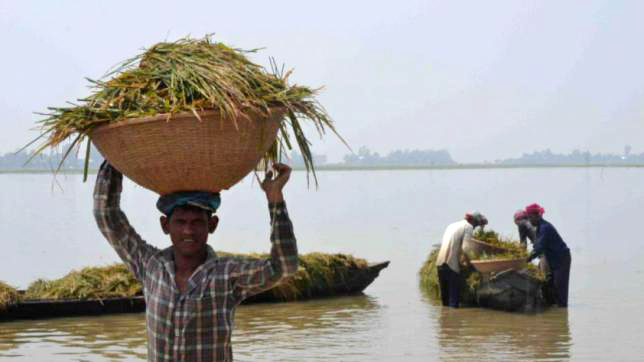Published in The Daily Star on Monday, 16 October 2017
WORLD FOOD DAY
Going regional to tackle local food crisis
 The food security situation in Bangladesh has been in troubled waters all through the year. The metaphor stands true in the literal sense as well, since the recent threats to food security are largely a result of the damage caused by two successive floods: the flash flood during April and the monsoon flood since late June.
The food security situation in Bangladesh has been in troubled waters all through the year. The metaphor stands true in the literal sense as well, since the recent threats to food security are largely a result of the damage caused by two successive floods: the flash flood during April and the monsoon flood since late June.
Today, World Food Day, is an opportune time to talk about where Bangladesh stands with regard to the overall food security situation, and the actions or inactions which have led us to this position.

Bangladesh has made significant progress in the context of food security. Bangladesh has achieved self-sufficiency in rice production (self-sufficiency ratio of rice being 99 percent), but it is vulnerable towards production loss caused by natural calamities. The self-sufficiency ratio is lower for other non-rice crops (FAO 2015). This improved production of rice has helped Bangladesh increase its Global Food Security Index from 34.7 in 2012 to 36.8 in 2016, but is still in the vulnerable category. Bangladesh has managed to improve its average dietary energy supply since the mid-1990s—108 percent as reported in 2015 (FAOSTAT).
However, Bangladesh, like most other South Asian countries, is dependent on cereals, roots and tubers (especially rice, the staple food), indicating unbalanced nutrition intake. Bangladesh has made strides in reducing the prevalence of undernourishment from 34.7 percent in 1993 to 16.4 percent in 2016 (FAOSTAT). Furthermore, the prevalence of wasting and stunting and of underweight children under five years of age has also gone down at varying degrees from their mid-1990s level.
Thus, one can conclude that even though the achievements as regards food security in Bangladesh have been somewhat satisfactory, the records are wanting and unstable. As a country vulnerable to natural calamities like flood, ensuring food security on a sustained basis is a huge concern for Bangladesh. This year, the challenge has been intensified by the influx of an estimated 5,36,000 forcibly displaced Rohingyas of Rakhine State of Myanmar.
The most evident threat to food security is the recent price volatility in the rice market. Already much has been said and done to identify and alleviate the reasons of the recent hike in rice price. The production loss of mainly Boro during the flash flood in the haor and low-lying areas in the northeast region and of crops during the monsoon flood which affected 32 districts can be deemed as the primary reasons of the obstinately high rice price.
Another major factor is the incompetence of the responsible authorities in handling the initial uncertainties in the food grains market, which was taken advantage of by opportunistic groups in the market. Information asymmetry regarding the export of rice by the Indian government; the government’s lack of vigilance as regards the depleting stock of rice in the public granaries; and phased reduction of import duties on rice (from 28 percent to 10 percent and then finally to two percent) have fuelled the upheaval in the rice market.
As a result, the lack of availability of food grains at reasonable price will afflict the marginally non-poor households and households below the poverty line. There is a possibility that even a marginally non-poor, food-secure household could find itself falling into the poverty trap with no (or inadequate) access to food. During urgent situations like this, the possibility of high pressure on the balance of payment due to import bills and food price inflation cannot be ruled out.
Although the government has opted for market-based procurement policies, it has been able to attain only one-fifth of the targeted procurement for Boro. Besides, the trade negotiations for importing rice were not fruitful enough to achieve market price correction.
Looking beyond national-level mechanisms towards regional-level collective mechanisms, the government of Bangladesh could have made use of the regional institution, the SAARC Food Bank (SFB). SFB can be viewed as a regional collective initiative to reduce vulnerability to food insecurity. It is an institution backed by the SAARC authority, set up in 2008, with the aim to ensure a regional food security reserve for the SAARC. This is a ready mechanism in place which can be made use of quite effectively only if the SAARC nations are willing and enthusiastic enough.
To put it simply, the SFB acts as a regional food reserve for rice and wheat (food grains) from which withdrawals can be made by the SAARC countries upon experiencing food emergency (a state where an affected SAARC country is unable to tackle a manmade or natural calamity with its national food reserve) or food shortage (a state caused by storage shortfall and/or production shortfall of eight percent from the average of previous three years’ production). The current quantum of reserve in the SFB is 486,000 metric tonnes (MT)—contributions made by all member countries with India as the highest contributor. A country can avail support from the SFB and later, when the emergency food shortage is settled, it can replenish the SFB stocks as per agreement with the SFB Board and member countries.
This year, Bangladesh was eligible to seek support from the SFB as the estimated loss of Boro rice production alone was 1,600,000 MT, which is about eight percent of the previous three fiscal years’ (FY14–FY16) national average of Boro rice production (CPD IRBD analysis).
However, as a CPD study points out, the SFB could not be brought into action despite some of the subsequent amendments to facilitate its operationalisation due to certain institutional bottlenecks. In recent times several of the impediments have been addressed, e.g. the removal of the stringent rule for withdrawal of food grains from SFB (the “eight percent production loss” condition of food shortage mentioned above), but this is yet to be finalised. Other problems like inadequate quantum of reserve, absence of agreed pricing modality, and lack of dedicated funds for SFB can and should be addressed in order to make SFB functional. The political willingness of the SAARC leaders in turning the provisions in the SFB Agreement into actions can help the countries prone to natural calamities in times of need.
A society free of hunger is now a global aspiration—enshrined in the 2030 global sustainable agenda. In order to achieve this goal, national and regional efforts must go hand in hand.
Sherajum Monira Farin is a research associate at the Centre for Policy Dialogue (CPD). Estiaque Bari is a senior research associate at CPD.

